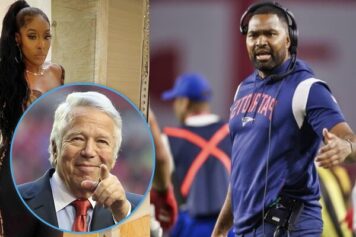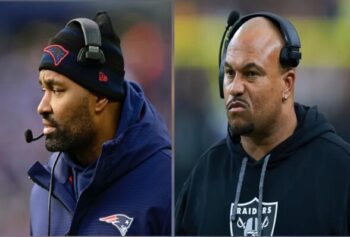Football is just a game, but Josh Gordon’s daily struggle is one of life and death.
“If you ever come looking for me, you know where I’m bound to be, in the bottle.
Turn around, look around on any corner, if you see some brother looking like a goner, it’s gonna be me…” – Gil Scott-Heron, The Bottle.
When Gil Scott-Heron’s classic cut, The Bottle, is pumped over a booming system, it’s easy to get lost in the incredible musicianship and elements that make your body vibrate. It takes some moments of reflection to become fully immersed in the lyricism and its inherent, biting social sermon and commentary on alcoholism and addiction.
In a parallel sports universe, it was easy to become enthralled with watching Josh Gordon‘s majestic athleticism, speed, strength and skills as a wide receiver on the football field.
We’d long known, going back to his college days at Baylor when his drug suspensions ruined what could have been one of the most iconic NCAA careers on par with the likes of Randy Moss while playing alongside Robert Griffin III, that Gordon had a problem with drugs and alcohol.
But those issues always seemed to take a back seat, with the thoughts focusing on when he’d return to the field as opposed to the internal fissures that have haunted this talented young man for most of his life.
Like Gil Scott-Heron’s brilliant cut, the deeper meaning of Gordon’s personal tragedy was always lost because his brilliance as an athlete was so exultant, it masked the importance of the overall message.
There is not one family in America that can claim that they’ve been immune to the plague of alcohol and drug addiction. Whether it’s a beloved parent, sibling, cousin or friend, we’ve all been negatively impacted by this scourge in one way or another.
And yet, when the news broke this morning that Gordon was stepping away from football once again, for the second time this season after having missed training camp with the Cleveland Browns, I was greeted with a social media timeline that focused on what that meant for his current team, the New England Patriots.
Some people went as far as to laugh at Gordon, and to vilify Patriots coach Bill Belichick and franchise owner Robert Kraft for signing the troubled receiver in the first place. They railed about what this would mean to their fantasy teams, or exulted in the fact that the Patriots would be missing their most potent offensive weapon heading into the playoffs.
Some simply called Gordon an incorrigible drug addict who never deserved to be in the NFL in the first place.
This afternoon, we learned that Gordon has been returned to the Reserve/Commissioner Suspended list indefinitely for violating the terms of his conditional reinstatement under the Policy and Program for Substances of Abuse.
Now official:
Effective today, Josh Gordon has been returned to the Reserve/Commissioner Suspended list indefinitely for violating the terms of his conditional reinstatement under the Policy and Program for Substances of Abuse.
— Adam Schefter (@AdamSchefter) December 20, 2018
He’s being shamed as a victim of his own stupidity. When in actuality, his struggle with substance abuse and mental health is as American as apple pie.
This isn’t a football story at all. It’s one of a man fighting against demons that have affected all of us, either directly or tangentially.
And really, when you boil it down, who cares if his NFL career is over?
That’s the least important part of the swirling discussion today. The most paramount question is, can this tortured young man reclaim a life of promise?
Gordon wasn’t merely a pot head, or someone who smoked weed to ease the physical pain that comes along with playing football.
https://twitter.com/TwitterMoments/status/1075767151183618053
He told GQ that he initially began self-medicating with Xanax, marijuana, and codeine in middle school. He said his initial usage stemmed from social awkwardness, anxiety, feelings of inadequacy, and “adolescent trauma-based fear.”
According to Gordon, the drugs helped “numb those nerves so [he could] just function every day.” When he was in seventh grade, Gordon said he took a “whole bar” of Xanax and ended up “nodding off” and “drooling” in class.
He grew up with two older brothers in a rugged section of southwest Houston, bouncing from place to place. Eviction notices appeared regularly and he was tossed out of two middle schools for robbing other students.
Marijuana and Xanax were as much a part of his daily diet in middle school as McDonald’s.
He was thrown out of Westbury Christian, a prep school in Houston, in 10th grade for marijuana. He then attended Lamar High, where he subsequently joined a gang, the Six Deuce Harvard Park Brim Bloods, an offshoot of the South Central L.A. street gang.
As Ben Baskin wrote in Sports Illustrated in November of 2017, as Gordon was trying to make his way back into the NFL after being suspended for two years –
“He’d go every morning to a tattoo parlor and pick up a small .38 special that he put in his pocket or backpack, then he’d return it at the end of the school day. Every weekend, he says, a fight would break out and there’d be a flurry of bullets; he caught one in the left arm during his junior year. Gordon says he never “maliciously” shot anyone, but he often had to shoot “to get out, to cause some type of hesitation—a pause so you could keep moving.” He says he sold drugs, mostly weed and mostly at school, “to feed myself.” But the majority of his income came from counterfeit money. The gang would spend $100 to get $2,000 in fake currency, Gordon says, then he would go to McDonald’s and buy five $1 cheeseburgers with a large bill in order to get the legit change.



